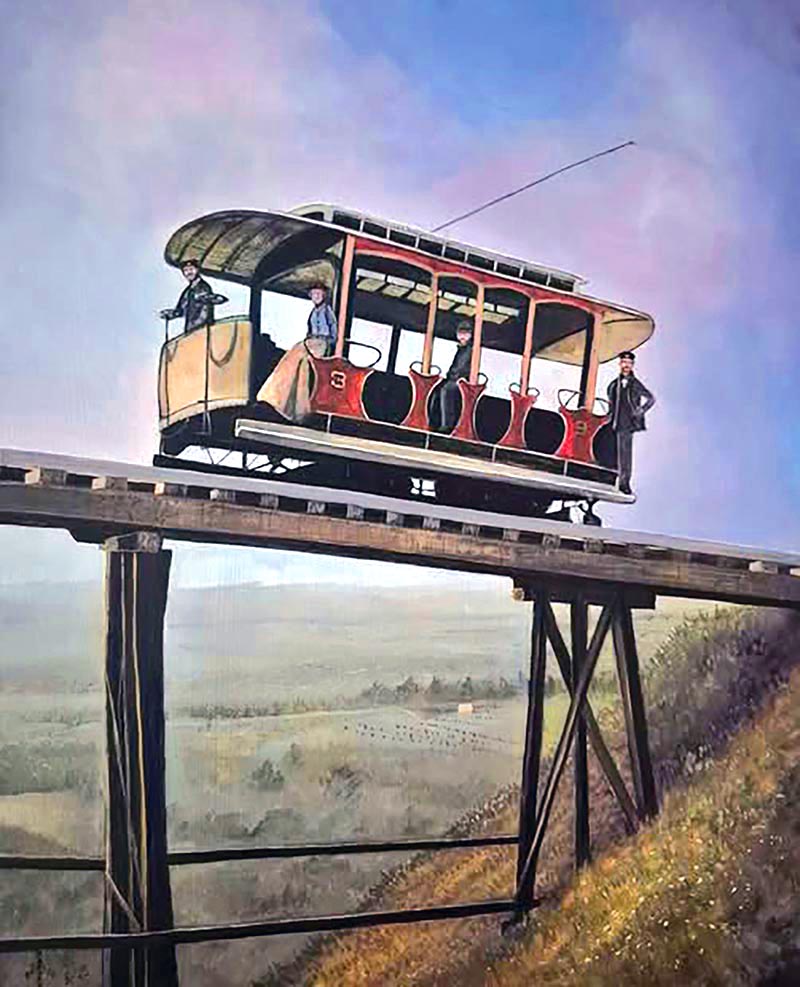It’s no secret that I like unusual railroads. That may be why I tend to model logging lines. I like that they tended to build their own unique equipment. I shared some of my unusual models in the January/February and May/June 2025 issues of the GAZETTE. So, when I saw Patrick Karnahan’s painting of a Mount Lowe cable hauled funicular railroad car I had to share it with you on this issue’s cover.
The Mount Lowe Railroad was a narrow gauge (42-inch?) trolley line that for nearly 40 years twisted up Mount Lowe, near Pasadena, Calif., rising some 3,130 ft. in 5.84 miles. It served several mountain hotels where one could commune with nature, or just get away from things, and an observatory. Part of the trip was by a funicular railroad with over 60 percent grades. The railroad was known as “The Most Scenic Mountain Railway in the World.”
The Mount Lowe Railroad was “built” by Professor Thaddeus S.C. Lowe, famous for bringing about the use of observation balloons by the Union Army during the American Civil War. Professor Lowe had retired to California after making his for-tune in refrigeration and was looking for a project to keep himself busy. The railway was very steep and circuitous with several trestles hanging out in space. One was almost a complete circle. Since the cars were open, it must have been a harrowing ride.
The railroad was eventually purchased by the mighty Pacific Electric and three new open two truck cars, with extra deep wheel flanges were built. Several fires on the mountain and failing tourist traffic forced the abandonment of the line in 1936.
Patrick’s painting shows the Echo, one of the closed cars used on the cable hauled part of the line. There were also open cars and some convertibles where the top tier could be enclosed. Most funicular railways run on four rails so ascending and descending cars can pass halfway along the line. Because of costs, the Mount Lowe Line had only three rails with a single point turnout to allow cars to pass. The cable system was designed by Andrew Hallidie, inventor of the famous San Francisco cable cars.
A close look at the passengers in Patrick’s painting shows silent movie star Buster Keaton in the doorway with scandal ridden Fatty Arbuckle to his left. The other figures represent Barbara La Marr known as, “The Girl Who is too Beautiful,” Rudolf Valentino, and Thaddeus Lowe. According to Patrick, all shared similar fates at the end of their lives of disillusionment of their dreams and aspirations. So he calls his painting “Their Final Flight.” For a complete history of this interesting railway find a copy of “Mount Lowe, The Railway in the Clouds,” by Charles Seims (1975, Golden West Books). I found this book and several others about the Mount Lowe Railroad available on Amazon.
Welcome Chris Lane
Sharon and I want to welcome Chris Lane to our production team as an Associate Editor. Chris is a long-time narrow gauge modeler and has been a GAZETTE reader since issue No. 2 in 1975. He has chaired two Narrow Gauge Conventions and is one of the book editors at White River Productions. The narrow gauge books he edited include: Slim Gauge Cars Second Edition, Rio Grande: The Early Years, 3 Days–20 Bucks: The Story of the Rocky Mountain Railroad Club’s NG Excursions, Eureka & Palisade, Rio Grande High-side Gondolas, The Shay Locomotive, Rio Grande K-36 Locomotives, Rio Grande K-28 Locomotives, and Over the Georgetown Loop: A History of Georgetown, Breckenridge & Leadville Railway.
He has edited the On30 Annual for the past 20 years, the HOn3 Annual for the past 17 years and the Garden Trains Annual for the past five years. He brings a vast experience in editing and magazine production to our team, and we look for-ward to seeing his articles, plans, and reviews in the GAZETTE.
Welcome Chris!
—Bob Brown, Editor

